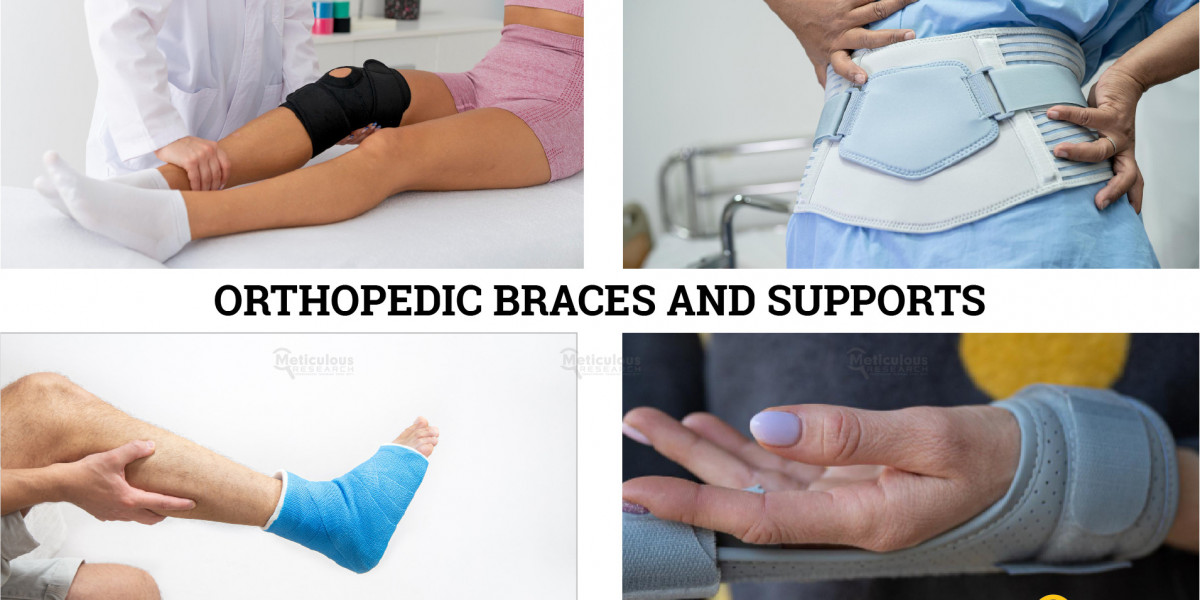The orthopedic braces and supports market is poised for significant growth, with projections estimating the market will reach $4.64 billion by 2031, at a compound annual growth rate (CAGR) of 5.4% from 2024 to 2031. This growth is primarily driven by the increasing incidence of bone fractures, the rising prevalence of musculoskeletal disorders, and the expanding availability and affordability of orthopedic support products. However, the market faces challenges, including low awareness regarding bracing-mediated treatments and the tendency of individuals to ignore minor injuries.
Market Growth Drivers
Growing Availability and Affordability of Orthopedic Support Products
The accessibility of orthopedic braces and supports has increased significantly, thanks to the proliferation of retail and e-commerce platforms. Products such as wrist and hand braces, elbow braces, ankle braces, and shoulder braces are now readily available over the counter. These products do not require medical supervision and are often used for preventive care, making them more accessible to the general public. The entry of major players into the market with new product launches further fuels this growth. For instance, Breg, Inc. introduced 15 new spine bracing products in February 2021, catering to patients with spinal injuries.
Increasing Bone Fracture Cases
Bone fractures are a significant driver of the orthopedic braces and supports market. Fractures typically occur when a force greater than what a bone can withstand is exerted. Common causes include vehicle accidents, falls, sports injuries, cancer, and osteoporosis. According to a report by The President and Fellows of Harvard College in June 2023, the global number of hip fractures is projected to nearly double by 2050 compared to 2018. Additionally, the World Health Organization reported that in 2019, around 528 million people worldwide were living with osteoarthritis, a figure that has nearly doubled since 1990. The increasing prevalence of osteoarthritis, particularly in the knee, hip, and hand, is expected to drive up the demand for orthopedic braces and supports.
Market Trends
Increasing Prevalence of Orthopedic Disorders and Diseases
Musculoskeletal disorders are on the rise globally, with the number of cases expected to double in the next few decades. By 2050, over a billion people are projected to suffer from joint, ligament, tendon, muscle, bone, and spine disorders, up from about half a billion in 2020. The World Health Organization's 2022 report indicated that approximately 1.71 billion people globally are living with musculoskeletal conditions, which are a leading cause of disability worldwide. Lower back pain is particularly prevalent, causing significant disability in around 160 countries. This rising prevalence is driving the demand for effective orthopedic braces and supports.
Rise in Sports-related Injuries and Road Accidents
The increase in road accidents and sports-related injuries is another critical factor propelling the orthopedic braces and supports market. For instance, in Germany, traffic accidents resulted in 29,000 injuries in November 2022, a 9% increase from the previous year. Similarly, Italy recorded 151,875 road accidents in 2021, resulting in 204,728 injuries. The participation of youth in sports activities has also surged, leading to a corresponding rise in sports-related injuries. In the U.S., nearly 232.6 million people engaged in organized sports and fitness activities in 2021, with around 1.1 million children aged 14 or younger treated for sports-related injuries in hospital emergency rooms. The growing incidence of such injuries is driving the demand for orthopedic braces and supports.
Market Restraints
Low Awareness Regarding Bracing-mediated Orthopedic Treatments
Despite the benefits of bracing-mediated orthopedic treatments, there is still a lack of awareness among consumers. These treatments involve the use of braces to restrict movement, relieve pressure, take weight off injured areas, promote healing, and provide post-operative support. However, many consumers prefer over-the-counter products like compression bandages and tapes, which offer temporary relief and are cheaper. In developing countries, the cost remains a significant barrier to the adoption of orthopedic braces and supports, limiting market growth.
Orthopedic Braces & Supports Market Analysis: Key Findings
By Product: Knee Braces & Supports Segment to Dominate
The market is segmented by product into knee braces and supports, ankle braces and supports, foot walkers and orthoses, back, hip, and spine braces and supports, neck and cervical braces and supports, shoulder braces and supports, elbow braces and supports, hand and wrist braces and supports, and facial braces and supports. In 2024, knee braces and supports are expected to dominate the market with a 29.7% share. This dominance is attributed to the high prevalence of knee-related orthopedic illnesses and the benefits provided by knee braces, such as tissue compression, healing promotion, and pain reduction.
By Type: Soft & Elastic Braces & Supports Segment to Lead
Based on type, the market is segmented into soft and elastic braces and supports, hinged braces and supports, and hard and rigid braces and supports. The soft and elastic braces and supports segment is expected to hold the largest share of 52.5% in 2024, owing to their cost-effectiveness, flexibility, and availability in various sizes and shapes.
By Application: Ligament Injury Segment to Lead
The market is also segmented by application into compression therapy, preventive care, osteoarthritis, ligament injury, post-operative rehabilitation, and other applications. The ligament injury segment is anticipated to hold the largest market share in 2024. This is due to the increase in sports injuries, the high use of braces during exercise to prevent ligament injuries, and the rising number of accidents causing ligament injuries.
By Distribution Channel: Retail Pharmacies Segment to Dominate
Based on distribution channel, the market is segmented into hospital pharmacies, retail pharmacies, e-commerce, and other channels. The retail pharmacies segment is expected to dominate in 2024 with the largest share, attributed to the increased availability of over-the-counter products and the convenience offered by retail pharmacies. However, the e-commerce segment is projected to witness the highest growth during the forecast period, driven by the growth in online purchasing, increased access to online medical stores, and discounts offered by e-commerce platforms.
Geographic Analysis
North America to Dominate the Market in 2024
Geographically, North America is expected to account for the largest share of the orthopedic braces and supports market in 2024, with a 36.7% share. The U.S. will likely dominate this region due to factors such as shifting demographics, increasing health conditions, a growing aging population, robust consumer demand, and high healthcare expenditure.
Asia-Pacific to Register the Highest Growth Rate
The Asia-Pacific region is anticipated to register the highest growth rate of 6.4% during the forecast period from 2024 to 2031. This growth is driven by the rising geriatric population, increasing prevalence of obesity, diabetes, and orthopedic diseases, and growing healthcare expenditures in economies like India and China. The rising cases of obesity and diabetes are likely to increase the burden of osteoarthritis, further driving market growth.
Key Players
The key players operating in the global orthopedic Braces and Supports market are Bauerfeind AG (Germany), Zimmer Biomet Holdings, Inc. (U.S.), 3M Company (U.S.), Össur hf. (Iceland), Breg, Inc. (U.S.), Enovis Corporation (U.S.), Bird & Cronin, LLC (U.S.), DeRoyal Industries, Inc. (U.S.), Essity Aktiebolag (publ) (Sweden), and Ottobock SE & Co. KGaA (Germany).
Download Sample Copy Here: https://www.meticulousresearch.com/download-sample-report/cp_id=5355
Key questions answered in the report-
· Which are the high-growth market segments in terms of product, type, application, and distribution channel?
· What was the historical market for orthopedic braces & supports market across the globe?
· What are the market forecasts and estimates for the period 2022–2029?
· What are the major drivers, restraints, opportunities, and trends in the global orthopedic braces & supports market?
· Who are the major players in the global orthopedic braces & supports market?
· How is the competitive landscape, and who are the market leaders in the global orthopedic braces & supports market?
· What are the recent developments in the orthopedic braces & supports market?
· What are the different strategies adopted by the major players in the orthopedic braces & supports market?
· What are the geographical trends and high growth regions/countries?
Contact Us:
Meticulous Research®
Email- sales@meticulousresearch.com
Contact Sales- +1-646-781-8004
Connect with us on LinkedIn- https://www.linkedin.com/company/meticulous-research








